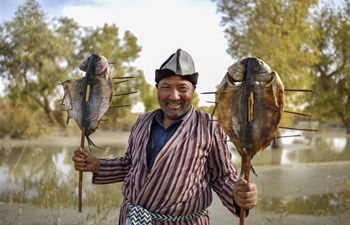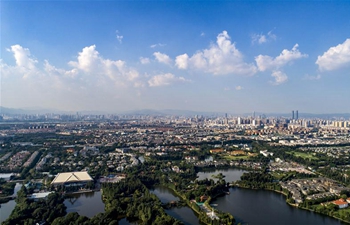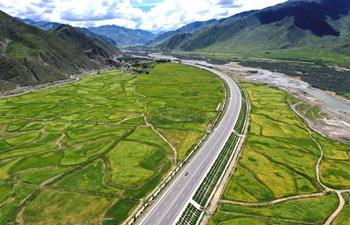HOHHOT, Aug. 22 (Xinhua) -- Strolling down the crowded streets of Kangbashi, Aaron Patterson felt fresh and revitalized, soaking himself in lush scholar trees and blooming malus rubies.
The 35-year-old British man has lived in Kangbashi for eight years and spends most of his time with the daily management of his English school in this modern district of Ordos, north China's Inner Mongolia Autonomous Region.
His connection with the district stems from a romantic relationship with a local Chinese girl from Ordos who studied in Britain and ultimately became his wife.
"A bustling new town rose straight from the ground in just 10 years, which was probably not enough to build a suburban road in many developed countries," Patterson said.
The construction of Kangbashi began in 2004 on a vast wasteland, some 30 square kilometers, in Ordos, just before Patterson's first visit to the city a year later.
Yet the newborn district was then branded a "ghost town" by the Western media for its "empty streets and abandoned high-rises," alluding to the "overheated bubbles" of the econommy.
That was pretty much the way Kangbashi was envisioned by Deon Visser, a South African horsebreaker, a splendid but uninhabited city built in the middle of a desert.
Visser was thus surprised by what met his eyes upon arriving at this far-off corner of China. "This is definitely no ghost town."
With elegant urban landscape and a greenery coverage of more than 15 million square meters through water-saving irrigation, the district has been graded as China's first 4A-level scenic area named after a city and is now home to 150,000 permanent residents.
The promising district also attracts people with its cinemas, exhibition centers, sports fields, shopping malls, as well as horse and auto racing.
Tourism provides 16 percent of Kangbashi's gross domestic product and over one-fourth of its employment. More than 2.8 million tourists visited Kangbashi last year, filling nearly all the hotel rooms, around 3,500 in the district, during travel season.
"Tourism is making the people of Kangbashi rich," said Wen Yunxiang with the local bureau of culture and tourism.
Tian Shenghua, deputy head of Kangbashi, said that the soaring industrial economy in the resource-rich Ordos demanded a new evolution of the existing urban framework to bring more room for development and meet the growing needs of industrial agglomeration and population inflow.
The city of Ordos has been looking for new growth engines through industrial structure upgrading as China devotes greater efforts to develop the western regions during the 13th Five-year Plan period (2016-2020).
What has happened in Kangbashi reflects the huge potential and strong resilience of the Chinese economy. The western region, with a faster pace, is providing an ever better living environment and career prospects for individuals.
Dutch chemical engineer Hans Niemantsverdriet was impressed by of the Ordos plant of Synfuels China Technology Co., Ltd., where he built a joint lab of R&D on coal-to-liquids technologies.
"The highly effective designs and environmentally friendly layouts of the plant are amazing," he said.

















